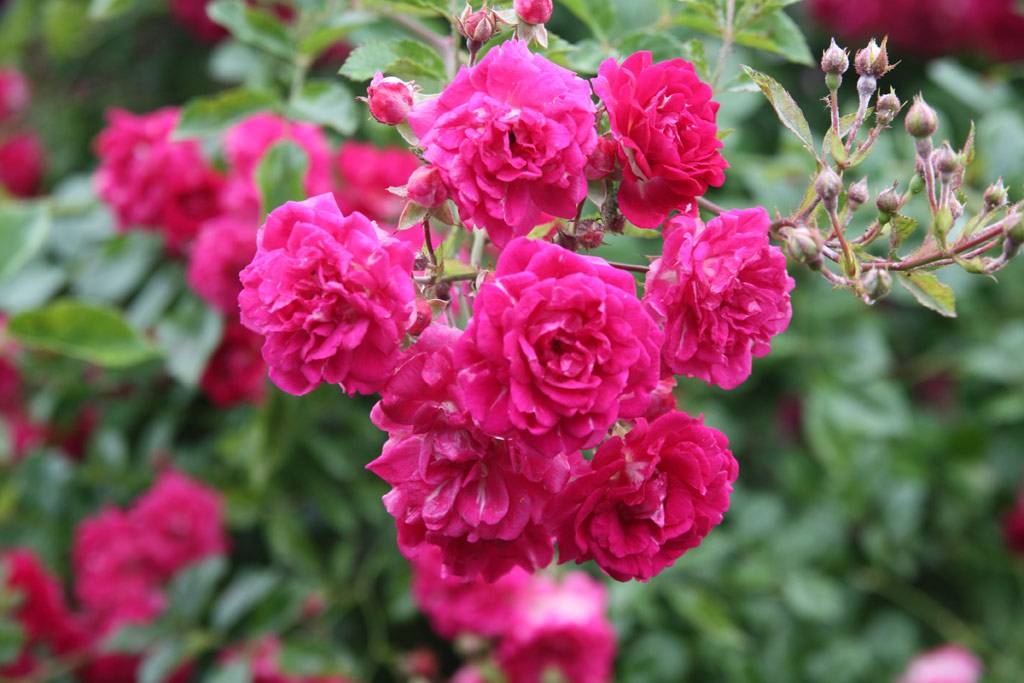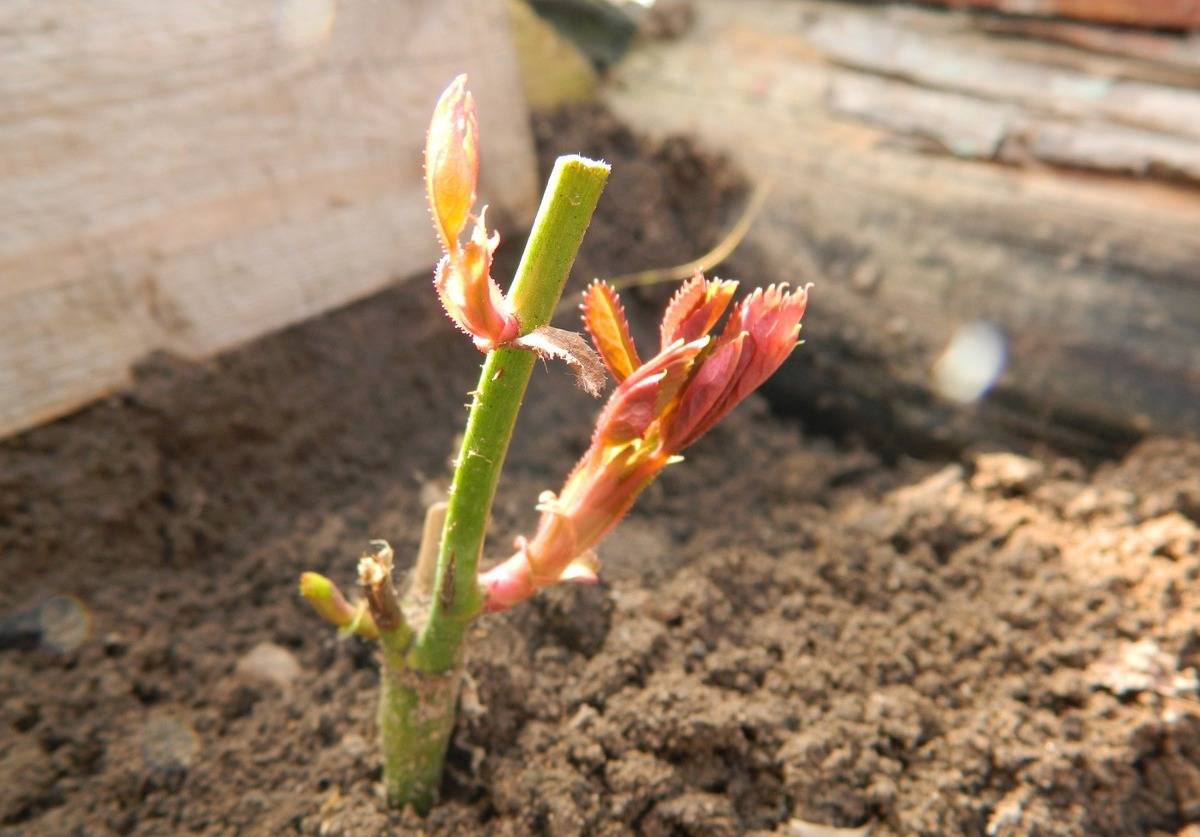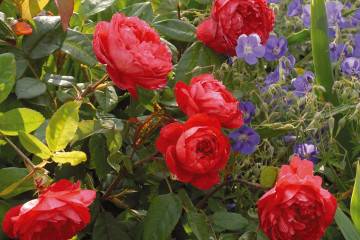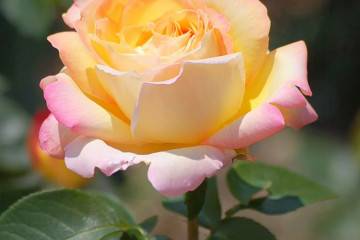Rose Excelsa - variety description
Content:
Climbing rose Excelsa looks great in single plantings and garden compositions. Knowing the requirements for caring for this perennial plant, you can create a real piece of paradise on your own plot.
Description of the variety of roses Excelsa, Red Dorothy Perkin
The Excels variety is considered to be quite old; it was created by the American breeder M. Walsh in the early 20th century.
The plant is a bush formed by long lashes on a short stem of no more than 10 cm. Liana-like shoots can spread up to 2 m in width, and reach 4 m in height. The branches of the bush are covered with oval emerald-green leaves with pointed tips. The flowers are not large, only 4-6 cm in diameter, but very lush due to the fact that they consist of 85-90 petals. The cluster inflorescences have about 55-60 buds, blooming almost simultaneously and covering the bush with a bright crimson-pink color. The aroma is subtle, with hints of vanilla. Flowering once during the season.
Climbing rose Excelsa, the description of which informs about resistance to fungal diseases, also has other positive characteristics:
- abundant flowering;
- increased frost resistance;
- the appearance of double flowers.
This rose also has its drawbacks. Among them are noted:
- an abundance of thorns on the branches, making it difficult to care for the plant;
- the tendency of colors to fade from sunlight;
- the need to cut off a huge number of wilting flowers.
Improved version of Super Excels
The result of many years of breeding work on Excelsa was a subspecies of the climbing rose called Super Excelsa, which took over its best qualities from the original variety. Its most important distinguishing feature is its ability to bloom again.
Growing a flower
In order to successfully grow Excelsa, it is important to plant it correctly. The procedure, although simple, has its own nuances.
Excelsu, which is a hybrid variety, is recommended to be planted in the ground with seedlings obtained by cuttings or rooting of cuttings. Planting seeds is too laborious and will not give the expected result.
It is recommended to plant Excelsi seedlings in mid-May or very early June. A plant planted at such a time adapts well and will have time to get stronger before the onset of winter cold weather. An autumn planting of a climbing rose threatens a heat-loving plant with freezing.
Seat selection
The site for planting Excels should be on a small hill. The plant is shown protection from drafts and gusts of wind. The plant should be shaded from the midday sun.
How to prepare the soil and seedling for planting
The soil for planting Excelsia requires loose, moisture and air permeable, loam is considered optimal.
The seedling should be immersed in water a day before planting, after which the lashes should be cut by 15-30 cm. The cuts must be sprinkled with crushed charcoal.
Planting procedure step by step
The beds for seedlings are formed in advance. They act in this way:
- In a chosen place near a wall or other support, planting holes are dug, leaving a distance of at least 60 cm between them.
- Drainage is laid at the bottom of the pit and sprinkled with earth.
- The rose is dipped into the hole, carefully spreading the roots.
- The pit is filled up, compacting the soil.
- The seedling is watered with settled water.
Do not forget that the distance to the support must be at least 0.5 m.
Plant care
Excelsa is quite unpretentious and resistant to external factors. Like any flowering plant, it needs special care.
Watering rules and humidity
Waterlogging is dangerous for a flower, which can cause rotting of the roots. Therefore, with regular precipitation, it is recommended not to water the bush, but in dry weather, limit yourself to 1-2 buckets of water once a week. After rain or watering, the soil is loosened to retain moisture and allow air to reach the roots.
Top dressing and soil quality
The abundantly blooming Excelsa must be fed regularly, starting from the second year of life. At the end of the first summer, potash fertilization is mandatory. In the next season, fertilizing with organic matter and minerals is alternated, and from the third year, only organic compounds are used, but at least 5 times per season.
Pruning and replanting
The pruning procedure is carried out in the spring and autumn periods. In the first case, broken and diseased shoots, as well as branches growing inside the bush, are removed. When pruning in autumn, the lashes are only slightly shortened, forming the crown of the bush.
It is possible to transplant the bush only if the wrong place was originally selected.
Features of wintering a flower
In the fall, dried out rain is removed from the lashes of roses, the shoots are pruned. The vines left behind are pulled with a rope, laid on a specially prepared bedding made of spruce branches, fixed and covered with dry leaves and non-woven material on top.
Blooming rose
For its excellent decorative qualities during the flowering period, this variety has been awarded three times at rose-growing exhibitions. The plant received gold medals in 1914, 1999 and 2001.
A period of activity and rest
Excelsa blooms at the end of June, forming buds on the shoots of the last year. Flowers continue to form and bloom for a month, followed by a rest period for the plant.
Care during and after flowering
During abundant flowering, it is necessary to remove wilted flowers from the bush almost daily. After the end of the period, the bush should be freed from all withered inflorescences so that it continues to look decorative.
Possible reasons for the lack of flowering
There are several main mistakes made by growers when growing this perennial. Rose Super Excels may not bloom for the following reasons:
- poor quality planting material;
- unsuitable landing site;
- the location of all lashes in a vertical plane and the depletion of external shoots.
Elimination of the listed problems and compliance with the rules of care will help to get a strong flowering plant.
Flower propagation
The best way to grow Excels is to use cuttings and cuttings as planting material. If you have an adult healthy bush, you can prepare seedlings yourself.
Cuttings can be carried out in summer or autumn, and it is recommended to lay the cuttings in the spring. They are separated only in the next season, when they take root and get stronger.
To root the cuttings in early spring, grooves are dug, inside which young lashes are pinned. Sprinkle them on top with soil, leaving the tips on the surface. You can separate the layers from the bush next year.
Diseases, pests and ways to control them
Despite its resistance to various diseases, Excelse can be threatened by bacterial cancer or powdery mildew. You can try to save the plant by cutting off and destroying the diseased parts, and treat what is left with copper sulfate.
Of the pests, aphids are the most annoying. At the initial stage of the lesion, spraying with soapy water is carried out. In serious attacks, it is recommended that an appropriate insecticide be used strictly according to the instructions.
Healthy Excelsa will be a real garden decoration. A properly planted climbing rose of this variety, with proper care, will actively curl and bloom profusely every year.



















